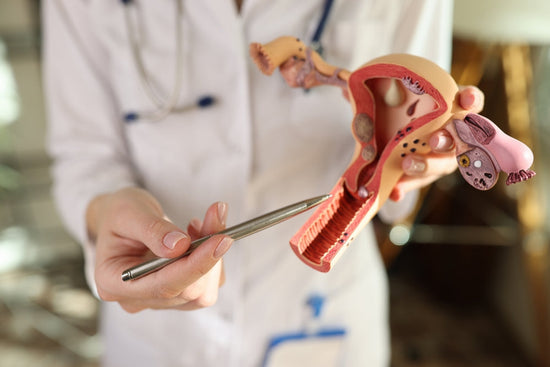A bloated stomach, cramps and diarrhea - that sounds anything but desirable!
The key word here is Intestinal flora . This should actually have a positive influence on your physical and mental health and plays an important role for your immune system. But there are some things that can really throw an intact intestinal flora out of balance. Did you know that there is also a close connection between the intestinal and the Vaginal flora Everything you need to know about disturbed and intact intestinal flora, as well as the influence on the vaginal flora, can be found in our new blog post.
How do I notice a disturbed intestinal flora?
The intestinal flora, also known as the microbiome, consists of many different intestinal bacteria. You may initially associate something negative with the term bacteria - but the Intestinal bacteria Microorganisms that are found in the intestines are by no means bad. They have the important task of forming the microbiome. This is particularly important for an intact immune system. But how can you tell that your intestinal flora is no longer intact?
We have listed some of the most typical Symptoms of a disturbed intestinal flora:
Abdominal pain
Bloated stomach
Cramps
nausea
Diarrhea and vomiting
fatigue
Headache
Intolerances
Do some of the symptoms listed sound familiar to you? Then you would certainly like to know how you can build up a healthy intestinal flora. Next, we will provide you with useful information regarding an intact intestinal flora.
Find the right Taynie for you.Discover our diversity!
How do I get good intestinal flora?
For an intact intestinal flora or microbiome, a healthy diet is essential.You may have heard that the use of a prebiotic and probiotic diet is a good support if you want to build up your intestinal flora.
Fermented foods in particular are real helpers, because they contain lactic acid bacteria that are good for your intestines. They are considered to be so-called probiotic foods. Does the term Probiotics Sound familiar? Probiotics are products that contain good bacteria. These are microorganisms that enter the intestine when ingested. If you buy pickled vegetables like sauerkraut the next time you go shopping, you will definitely be doing your intestinal flora a favor. However, you can also take probiotics in the form of capsules, powder or tablets and thus benefit from the microorganisms.
Your gut not only loves fermented foods, but also a sufficient supply of fiber. Overall, you should aim for a daily fiber intake of 30 grams; you can increase this slowly to avoid initial stomach pain. If you include grains in your diet, it is recommended that you choose the whole grain variety.
In addition, the prebiotic foods , the so-called indigestible components that can be found in food, for example foods with inulin, such as sweet potatoes, garlic and chicory. Another important keyword here: resistant starch. Foods such as rice, potatoes and pasta contain this if you let them cool down after cooking. However, you can then reheat them. So you can see that you can build up good intestinal bacteria in your body through your diet.
What destroys the intestinal flora?
Do you want to make sure that your intestinal flora remains intact? Then it makes sense to prevent some things that can harm your healthy intestinal flora. Risk factors Factors that can lead to a disturbed intestinal flora include an unhealthy diet, too little exercise and constant stress. In addition, some medications and antibiotics can damage your intestinal flora. Did you know that even the contraceptive pill can have a negative effect on your intestinal flora? In addition to medications and antibiotics, a change in the environment can also damage your intestinal flora. This is the case when you travel, for example - you may be familiar with the annoying phenomenon known as "traveler's diarrhea" in this context.
Which intestinal bacteria for vaginal flora?
Did you know that there is a central similarity between intestinal and vaginal flora? The key word here is the Lactic acid bacteria , also known as lactobacilli, which create an acidic environment. The acidic environment can create a defense that protects the body from pathogens. The healthy intestinal bacteria, as well as the lactobacilli of the vaginal flora, have the important task of creating an intact immune system for the body. Another interesting fact for you: the vaginal flora is formed in childhood when microorganisms are ingested orally.
So you can remember the following: The vaginal flora consists of bacteria, the so-called Lactobacilli , which are also crucial for an intact intestinal flora. Their job is to produce lactic acid, which is necessary for the acidic pH value of the vaginal environment.
The vaginal flora is closely connected to the intestinal flora, which is partly due to the fact that the vaginal and intestinal flora are close to each other and they are also very similar in terms of their microbiome. Are you curious and want to know more about the connection between Lactic acid and a healthy vaginal flora? Then you will here with one click to our blog post.
How do you notice a disturbed vaginal flora?
One disturbed vaginal flora can be quite unpleasant for those affected. It is not uncommon for itching, burning and discharge to occur on the
How can I rebuild the vaginal flora?
Have you ever wondered what you can do to maintain a healthy vaginal flora? You may already know that a healthy vaginal flora is characterized by the fact that many of the bacteria that are found in a balance are. If the vaginal flora is disturbed, these good bacteria are out of balance, so the balance must first be restored. There are actually a few tips and tricks that can help you restore the balance of bacteria in your vaginal flora. You can also use these to prevent a disturbed environment.
You've probably heard that you should always wipe from the vagina to the anus after going to the toilet. This prevents bacteria from the intestines from getting into your vagina, as they could cause havoc there and upset your vaginal flora. Excessive or inadequate intimate hygiene can also have a negative effect on the vaginal flora. Did you know that your vagina should only be washed with lukewarm water to maintain the acidic pH value? Read it here in our blog post.
But the vaginal flora is similar to the intestinal flora, because antibiotics or hormonal contraceptives can kill the lactic acid bacteria in the vagina.
Your doctor can also advise you about taking probiotics and prebiotics to further strengthen your vaginal microbiome.





